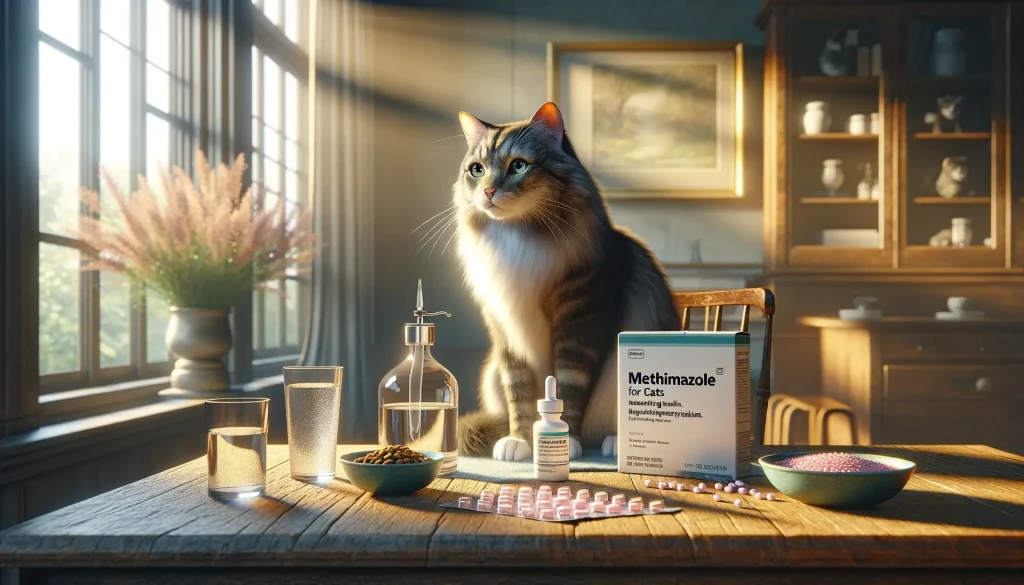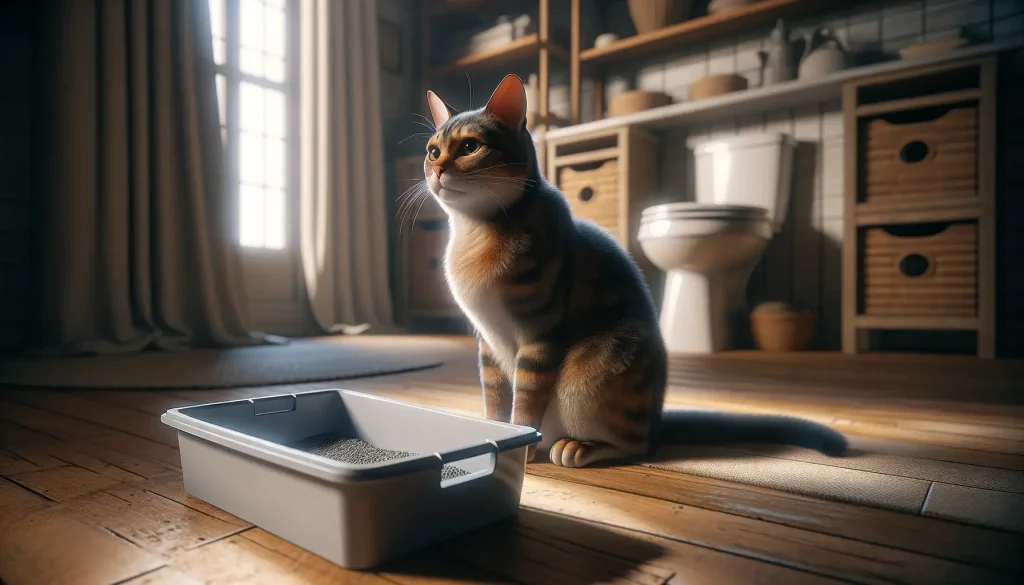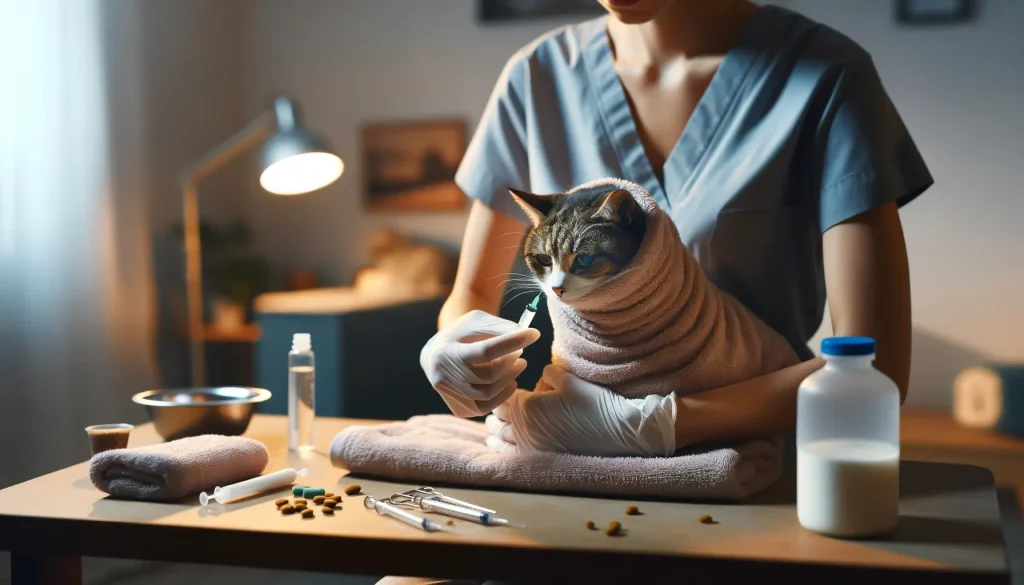
Force-Feeding Your Cat
Understanding how to force-feed your cat safely and gently is crucial to avoid causing additional stress or injury to your pet. The guidance of a veterinarian is indispensable in this process, as they can assess the cat’s condition, recommend whether force-feeding is appropriate, and advise on the method and type of food to use.
Key Considerations
- Vet Advice: Before force-feeding, consult your vet for tailored guidance, ensuring safety and efficacy based on your cat’s health.
- Right Tools: Use vet-recommended tools like syringes or feeding tubes gently to deliver food without causing distress.
- Food Choice: Opt for liquid or semi-liquid food advised by your vet, possibly therapeutic for force-feeding situations.
- Handle with Care: Minimize stress by handling your cat calmly with gentle movements and a soft voice.
- Proper Technique: Learn from your vet the correct positioning and pace to safely administer food, preventing choking or aspiration.
Best Practices
- Preperation: Gather all supplies beforehand and ensure food temperature is suitable, close to body heat.
- Position: Secure a comfortable spot for your cat; consider using a “kitty burrito” wrap to keep them calm and prevent scratching.
- Patience: Respect the pace of force-feeding; allow your cat time to swallow comfortably, offering breaks and reassurance as needed.
- Monitoring: Stay vigilant for signs of distress or refusal; pause or retry later if your cat becomes too stressed or aggressive.
When to Force-Feed
Deciding when to force-feed a cat is a delicate decision that hinges on the recognition of specific signs indicating that such an intervention might be necessary. Cats are notorious for their stoicism, often concealing pain or discomfort until it becomes severe. A significant and sudden change in their eating habits can be a red flag, signaling potential health problems. If your cat shows reluctance or outright refuses to eat for more than 24 hours, it’s critical to take action by consulting with a veterinarian. This step is imperative because cats can quickly develop serious health issues, such as hepatic lipidosis, when they stop eating.

Key Signs That May Warrant Force-Feeding
- Weight Loss: Even slight changes in weight can be significant for a cat. If you notice your cat losing weight, especially if it seems rapid or unexplained, it’s a cause for concern.
- Lethargy: A noticeable decrease in energy levels or interest in activities they usually enjoy can be a sign of underlying health issues.
- Refusal to Eat: While cats can be finicky eaters, outright refusal to eat anything for more than a day is alarming. This is especially true if they are not showing interest in foods they typically enjoy.
- Other Symptoms: Vomiting, diarrhea, or any other unusual symptoms accompanying a refusal to eat should be taken seriously.
Consulting Your Veterinarian
Before force-feeding, it’s crucial to seek professional advice. A veterinarian can assess whether your cat’s condition justifies force-feeding and rule out or treat underlying causes of their refusal to eat. The vet might also attempt other strategies first, such as offering highly palatable or specially formulated foods that could stimulate your cat’s appetite naturally.
Alternative Interventions
Force-feeding is generally considered a last resort after all other methods have been tried and failed. These methods may include:
- Offering a Variety of Foods: Sometimes, offering different flavors or textures can entice a cat to eat. This could include warming the food or trying different brands or types of food.
- Enhancing Food Appeal: Enhancing the smell or flavor of food, perhaps with a small amount of fish oil or a specially designed appetite stimulant, can sometimes encourage a cat to start eating voluntarily.
- Medicinal Appetite Stimulants: Your vet may prescribe appetite stimulants as a less invasive first step before proceeding to force-feeding.
The decision to force-feed should never be taken lightly and always under the guidance of a veterinarian. Force-feeding can be stressful and potentially harmful if not done correctly, so it should only be considered when a cat’s life is at risk from not eating and all other strategies have failed. Understanding the signs and seeking prompt veterinary advice can help ensure that you’re taking the right steps for your cat’s health and well-being.
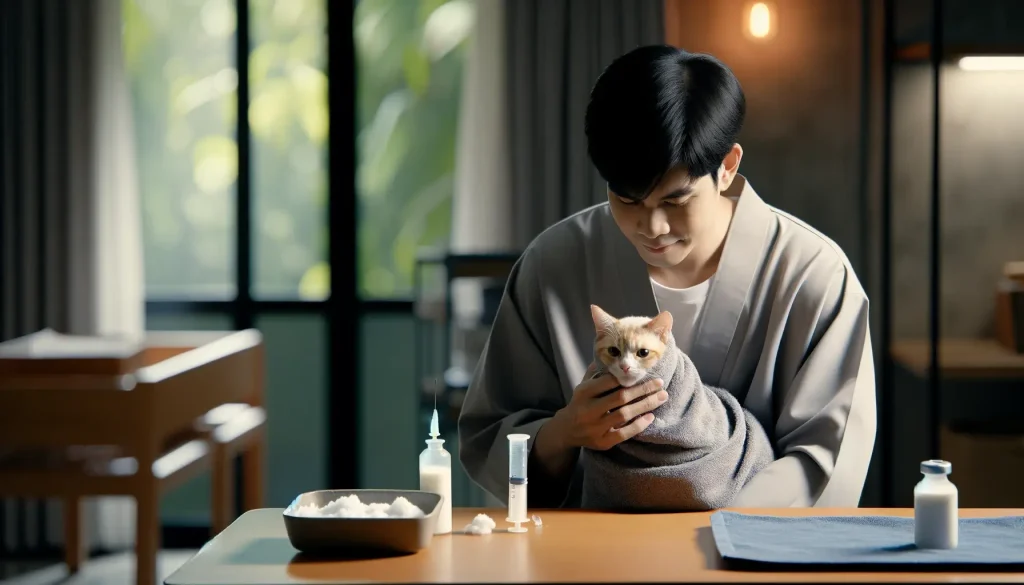
Before You Begin the Force-Feeding
Before embarking on the force-feeding process with your cat, thorough preparation is essential to ensure the procedure is as stress-free and safe as possible for both you and your pet. Here’s a step-by-step guide on how to prepare:
Gather Necessary Supplies
- Feeding Syringe or Tube: Depending on your veterinarian’s recommendation, you’ll need a syringe for syringe feeding or a feeding tube for tube feeding. Ensure it’s the appropriate size for your cat.
- Recommended Food: Use the specific type of food recommended by your vet, which is usually a high-calorie, easily digestible, wet food or a special recovery diet that can be liquefied for syringe or tube feeding.
- Water: For hydration and to mix with the food if needed to reach the correct consistency for feeding.
Create a Comfortable Setting
- Quiet Space: Choose a quiet, comfortable area where you can sit with your cat, free from distractions or loud noises that could increase their stress.
- Comfortable Positioning: Have a towel or blanket ready to gently wrap or position your cat if needed, helping them feel secure and reducing movement during feeding.
Familiarize Yourself with the Equipment
- Practice with the Syringe or Tube: Before using it on your cat, practice drawing up the food into the syringe or tube to ensure you’re comfortable with the mechanism. This helps prevent fumbling during the actual feeding, which could cause stress for your cat.
Understand the Feeding Instructions
- Quantity and Frequency: Have a clear understanding from your vet about how much food your cat needs and how often you should be feeding them. This is crucial to avoid the risks of overfeeding or underfeeding.
- Feeding Technique: Ask your vet to demonstrate the proper technique for syringe or tube feeding, including how to hold your cat’s head and the syringe, how to introduce the syringe into the cat’s mouth, and the rate at which to administer the food.
Prepare the Food
- Consistency: Ensure the food is at the right consistency, which may require blending or mixing with water. It should be smooth enough to go through the syringe or tube easily but still provide the necessary nutrition.
- Temperature: Warm the food to just below body temperature to make it more palatable and easier for your cat to accept. However, be careful to avoid making it too hot.
Stay Calm and Patient
Your demeanor can significantly impact how your cat responds to force-feeding. Approach the process with calmness and patience, speaking softly to your cat and taking breaks if they become distressed.
Preparation is crucial for a successful force-feeding experience. By taking the time to gather the right supplies, familiarize yourself with the equipment and process, and create a calm environment, you can make force-feeding as gentle and effective as possible for your cat. Always follow your veterinarian’s advice closely, and never hesitate to reach out to them with any questions or concerns you may have during the process.
When to Visit the Vet
Despite your best efforts at home, some signs should prompt an immediate vet visit. Pay attention to:
- Continuous Lack of Appetite: If your cat refuses to eat for more than 24 hours despite force-feeding attempts.
- Dehydration Signs: Sunken eyes, lethargy, or a ‘tenting’ skin test showing slow return to position.
- Behavior Changes: Unusual aggression, hiding, or excessive vocalization can indicate discomfort or pain.
- Physical Symptoms: Vomiting, diarrhea, or constipation that persists for more than a day.
These indicators suggest your cat may need medical attention beyond what you can provide at home.
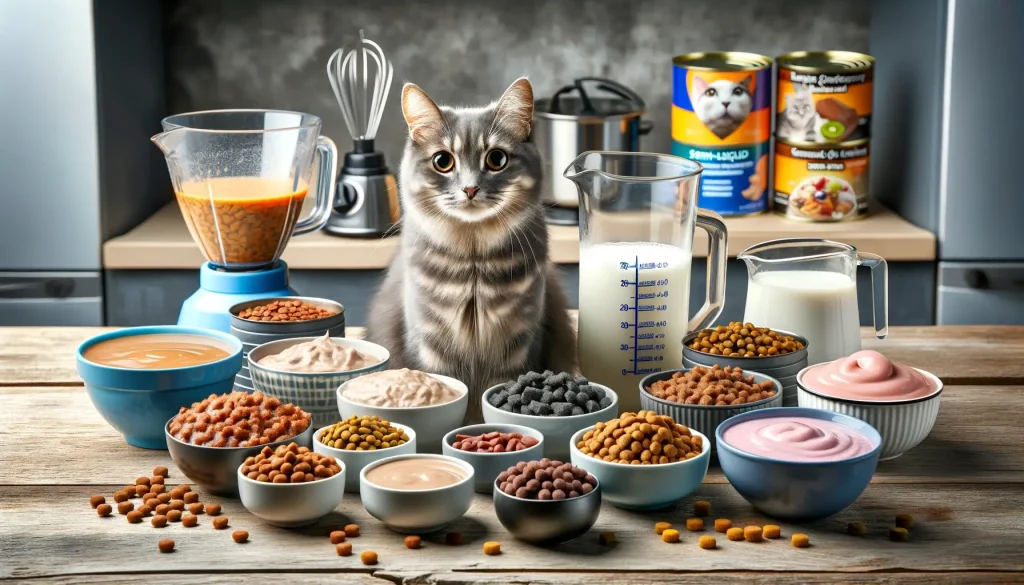
Choosing the Right Diet for Force-Feeding
When it comes to force-feeding, selecting the appropriate diet plays a critical role in ensuring your cat receives the necessary nutrients without causing additional stress or health issues. Here, we’ll break down how to choose the best food for the process.
- Veterinarian-Recommended Foods: Your vet can prescribe specific diets designed for easy digestion and optimal nutrient absorption. These foods often come in a form that’s easy to syringe-feed.
- Consistency is Key: The consistency of the food should be smooth and thin enough to pass through a syringe but still nutritious. Blending wet cat food with a small amount of water or broth can achieve the desired consistency.
- Nutrient-Rich Options: Look for high-calorie, nutrient-rich foods that support your cat’s recovery. These should include a balance of proteins, fats, and essential vitamins and minerals.
- Avoid Certain Ingredients: Some ingredients may cause more harm than good during this sensitive time. Foods high in carbohydrates, additives, or unfamiliar ingredients should be avoided or discussed with your veterinarian.
Choosing the right diet for force-feeding your cat can significantly affect their recovery process. Always prioritize foods that are easy to digest, nutritious, and vet-approved for the best results.
Remember, every cat is unique, and their nutritional needs may vary based on their health status and individual preferences. Collaboration with your veterinarian is crucial to tailor the diet that best suits your feline friend during force-feeding and ensures a smooth and safe recovery process.
Post Force-Feeding
After force-feeding, it’s vital to monitor your cat for any adverse reactions. Offer water and a comfortable resting area. Keep track of their hydration and bathroom habits. Sometimes, cats may need encouragement to drink water, so consider using a syringe or offering ice cubes. Regular check-ins with your vet are essential during this period to adjust feeding amounts and schedules as your cat’s condition improves.
Force-feeding your cat is not an easy decision, nor is it a straightforward task. It’s a procedure that requires understanding, preparation, and a lot of patience. With these steps, you can ensure that you’re doing it as safely and comfortably as possible for your feline friend.

Preventing Force-Feeding
Preventing eating issues in cats is crucial for their health and well-being. This section outlines practical steps to ensure your cat remains interested in their meals, potentially reducing the need for force-feeding.
- Regular Vet Check-Ups: Regular visits to the vet can catch health problems early, preventing eating issues related to illness.
- Quality Diet: High-quality, nutritious food is vital. Offer a variety of textures and flavors to keep meal times interesting.
- Stress Reduction: Cats are sensitive to changes in their environment. Keep their living area calm and introduce changes slowly.
- Proper Hydration: Always provide fresh water. Consider a cat water fountain to encourage drinking, which can improve overall appetite.
- Monitor Eating Habits: Keep an eye on how much and how often your cat eats. Early detection of changes can be a lifesaver.
- Dental Care: Regular dental check-ups and cleanings can prevent dental issues that may lead to feeding problems.
Avoiding force-feeding through prevention is the goal. Following these steps can help maintain your cat’s health and keep feeding issues at a distance.
Beginner Guide to Raising Quail at Home
What are the Signs of a Dog Concussion?
What Causes Your Dog’s Ears to Smell Bad?
When your dog’s ears start to emit an unpleasant odor, it might leave you puzzled…
Methimazole Treatment for Cat Hyperthyroidism
Methimazole plays a crucial role in managing feline hyperthyroidism, a condition marked by an overactive…
Got Hummingbirds in your Backyard? Here’s How to Care for Them.
Why Does Your Cat Pee Outside the Litter Box?
Cat’s Litter Box Issues It’s not uncommon for cat owners to face the frustrating dilemma…



